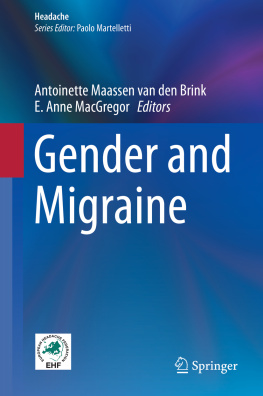Acclaim for Oliver Sackss
Migraine
So erudite, so gracefully written, that even those people fortunate enough never to have had a migraine in their lives should find it equally compelling.
The New York Times
Superb.
The Observer, London
To Sacks a headache is a mine of treasures, a source of visions, a microcosm of human experience and suffering, the philosophers stone. A remarkable achievement.
Sunday Telegraph, London
Delves into the workings of the brain with brilliant complexity.
Cosmopolitan
Sufferers will take comfort in seeing their condition thought about with such clarity.
Independent, London
The most comprehensive and readable book on this subject.
Library Journal
A seminal work of great interest and importance.
Journal of the Institute of Health Education
Provides fascinating insights into the interrelationships of mind, brain, personality, and culture.
Psychology Today
BOOKS BY Oliver Sacks
Oaxaca Journal
Uncle Tungsten: Memories of a Chemical Boyhood
The Island of the Colorblind
An Anthropologist on Mars
Seeing Voices: A Journey into the World of the Deaf
The Man Who Mistook His Wife for a Hat
A Leg to Stand On
Awakenings
Migraine

From a MS of Hildegards Scivias, written at Bingen about 1180. This figure is a reconstruction from several visions of migrainous origin (see ).
FIRST VINTAGE BOOKS EDITION, SEPTEMBER 1999
Copyright 1992 by Oliver Sacks
All rights reserved under International and Pan-American Copyright Conventions. Published in the United States by Vintage Books, a division of Random House, Inc., New York, and simultaneously in Canada by Random House of Canada Limited, Toronto. Originally published in the United States by the University of California Press, Berkeley and Los Angeles, California, in 1970 and subsequently revised in 1985 and 1992.
Grateful acknowledgment is made to Basic Books and Tavistock Publications for permission to reproduce two diagrams from Higher Cortical Functions in Man by A. R. Luria; to Constable and Co. for permission to reproduce five diagrams from C. Singers From Magic to Science; and to the American Medical Association for permission to reproduce two diagrams from an article by K. Lashley published in the Archives of Neurology and Psychiatry of 1941. These, and other diagrams from original sources, have been redrawn and somewhat modified. The publisher is also grateful to the British Migraine Association and Boehringer Ingelheim Ltd. for permission to reproduce paintings from their collection of migraine art; and to Dr. Ronald K. Siegel for permission to reproduce .
Vintage Books and colophon are registered trademarks of Random House, Inc.
Library of Congress Cataloging-in-Publication Data Sacks, Oliver W.
Migraine / Oliver Sacks. Rev. and expanded ed.
p. cm.
eISBN: 978-0-307-37106-5
1. Migraine. I. Title.
RC392.S33 1999
616.857dc21 99-33021
www.vintagebooks.com
v3.1
To my parents
Socrates, in Plato, would prescribe no Physick for Charmides headache till first he had eased his troublesome mind; body and soul must be cured together, as head and eyes.
Robert Burton
Whoever sees in illness a vital expression of the organism, will no longer see it as an enemy. In the moment that I realise that the disease is a creation of the patient, it becomes for me the same sort of thing as his manner of walking, his mode of speech, his facial expression, the movements of his hands, the drawings he has made, the house he has built, the business he has settled, or the way his thoughts go: a significant symbol of the powers that rule him, and that I try to influence when I deem it right.
George Groddeck
Contents
Introductory Comments Headache Nausea and Associated Symptoms Facial Appearance Ocular Symptoms Nasal Symptoms Abdominal Symptoms and Abnormal Bowel-Action Lethargy and Drowsiness Dizziness, Vertigo, Faintness and Syncope Alterations of Fluid Balance Fever Minor Symptoms and Signs: Pupillary Abnormalities, Horners Syndrome, Bradycardia, Multiple Ecchymoses, Whitening of Hair, etc. Organic Irritability and Photophobia Mood-Changes Symptom-Constellations in Common Migraine The Sequence of a Common Migraine: Prodromal Symptoms, Modes of Resolution, Post-Migrainous Rebound Concluding Comments Postscript (1992)
Introductory Comments Cyclic Vomiting and Bilious Attacks Abdominal Migraine Periodic Diarrhoea Periodic Fever Precordial Migraine Periodic Sleep and Trance-States Periodic Mood-Changes Menstrual Syndromes Alternations and Transformations of Migraine Borderlands of Migraine: Vagal Attacks, Faints, Reactions to Heat, Exhaustion, Passive Motion, Alcohol, etc. Alternations and Concomitances with other Disorders: Asthma, Angina, Laryngospasm, Sleep-Disorders, Peptic Ulcer, Ulcerative Colitis, Crohns Disease, Psoriasis, etc. Differential Diagnosis of Migraine Equivalents Concluding Comments
Introductory Comments: Historical Descriptions of Migraine Aura Specific Visual Hallucinations: Phosphenes and Elementary Hallucinations, Varieties of Migraine Spectra, Characteristics of Scintillating and Negative Scotomata Specific Tactile Hallucinations: Paraesthesiae, Anaesthesia Other Sensory Hallucinations: Auditory, Olfactory, Taste, Epigastric, Motor, Vertiginous, etc. Pseudo-objectivity of Migraine Hallucinations General Alterations of Sensory Threshold Alterations of Consciousness and Postural Tone Specific Motor Disorders: Weakness, Paralyses, Spasms, Seizures Alterations of Affect and Mood Disorders of Higher Integrative Functions: Complex Visual Distortions (Micropsia and Macropsia, Mosaic and Cinematographic Vision, Metamorphopsias, Visual Agnosias, etc.) Complex Apraxias, Agnosias, and Distortions of Body-Image Aphasias Time-Distortions, Dj Vu, and Forced Reminiscence Dreamy States Migrainous Deliria and Psychoses Illustrative Case-Histories Comments on the General Structure of Migraine Aura: Its Differential Diagnosis and Distinction from Epilepsies Classical Migraine Postscript (1992): The Angst of Scotoma
Migrainous Neuralgia: Synonyms, Typical Features, Illustrative Case-Histories Hemiplegic and Facioplegic Migraine: Typical Features, Possible Mechanisms of Attack, Case-Histories Ophthalmoplegic Migraine Pseudo-Migraine: Organic Lesions Simulating Migraine Permanent Neurological or Vascular Damage from Migraine
Introductory Comments, Components and Functional Levels of Migraine, Psychophysiological Stages of Migraine, General Characteristics of Migraine: Relation to Sleep, Epilepsy, etc.
Introductory Comments Overall Incidence of Migraine Familial Occurrence and Inheritance of Migraine Signs of Migrainous Constitution Migraine Diathesis in Relation to Other Disorders Migraine in Relation to Age General Discussion and Conclusions
Migraine and Other Biological Cycles Time Between Attacks: Relation Between Frequency and Severity of Attacks Immunity Between Attacks Signs of Approaching Attacks Intrinsic and Extrinsic Determinants of Periodicity Conclusions: The Notion of Idiopathy Postscript (1992)

















